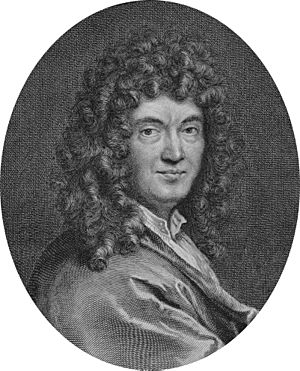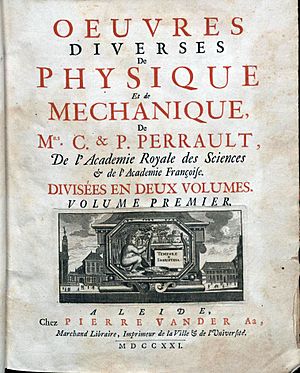Claude Perrault facts for kids
Quick facts for kids
Claude Perrault
|
|
|---|---|

Engraved portrait of Perrault by Gérard Edelinck
|
|
| Born | 25 September 1613 Paris
|
| Died | 9 October 1688 (aged 75) Paris
|
| Education | Doctor of Medicine |
| Alma mater | University of Paris |
| Occupation | architect, physician, writer |
|
Notable work
|
East façade of the Louvre |
| Relatives | Charles Perrault (brother) Pierre Perrault (brother) |
Claude Perrault (born September 25, 1613 – died October 9, 1688) was a talented French scientist and architect. He is most famous for helping design the beautiful east façade of the Louvre in Paris. He also designed the Paris Observatory. Perrault was a doctor, an anatomist (someone who studies the body), and a writer. He wrote many books about architecture, physics, and nature.
Contents
Who Was Claude Perrault?
Claude Perrault was born and passed away in Paris, France. He had a famous brother named Charles Perrault. Charles is well-known for writing down classic fairy tales like Cinderella and Sleeping Beauty.
Claude Perrault was a skilled doctor and a natural philosopher. He earned his medical degree from the University of Paris in 1642. In 1666, he became one of the first members of the French Academy of Sciences. This was a new group for top scientists in France.
Designing the Louvre Palace
King Louis XIV asked a special committee to design the east façade of the Louvre. This committee, called the Petit Conseil, included Perrault, Louis Le Vau, and Charles Le Brun. They started building in 1667, and the main part was finished by 1674.
By 1680, King Louis XIV moved his attention to the Palace of Versailles. The section behind the east façade of the Louvre was not fully completed until the 1800s. Many people believe Perrault created the final design for the east façade. He made important changes to make sure the building was strong. He also thought of using iron rods to help support the stone structure.
Perrault also drew plans to connect the Louvre with the Tuileries Palace. These plans were never fully built.
Other Famous Buildings and Designs
Perrault designed the Paris Observatory between 1667 and 1669. This building was a research center for the French Academy of Sciences.
He also designed a triumphal arch for Rue St-Antoine in Paris. His design was chosen over others, but only part of it was built. When the arch was taken down much later, people found that Perrault had designed the stones to fit together perfectly without mortar. This made the structure incredibly strong. He also created a design for rebuilding the church of Sainte-Geneviève in Paris, but this plan was not used.
Perrault's Writings and Discoveries
Besides his work on the Louvre, Perrault became well-known for translating a very old book. He translated the ten books of Vitruvius into French. Vitruvius was a Roman architect, and his book is the only surviving Roman work on architecture. Perrault added his own notes to the translation, which was published in 1673. In 1683, he wrote his own book about the five main styles of classical orders in architecture.
Perrault also made important discoveries about sound. He wrote about how sound travels, where it comes from, and how we hear it. He studied how different musical notes work together to create harmony. His work helped people understand more about how music works.
Written works
- Les dix livres d'architecture de Vitruve (The Ten Books of Architecture by Vitruvius), 1673.
- Mémoires pour servir à l’histoire naturelle des animaux (Memoirs for a Natural History of Animals), 1676.
- Essais de Physique (Essays on Physics), 4 volumes, 1680–1688.
- Ordonnance des cinq espèces de colonnes selon la méthode des anciennes (Rules for the Five Kinds of Columns According to the Method of the Ancients), 1683.
Images for kids
-
General plan of Perrault's second project for the joining of the Louvre and the Tuileries, engraved by Jacques-François Blondel
See also
 In Spanish: Claude Perrault para niños
In Spanish: Claude Perrault para niños






